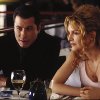|
How did we ever live before this marvelous little device?
I was reminded of our good fortune to live in such modern times on Sunday when the cold weather propelled me into a warm corner to watch the Giants-Packers playoff. It’s been a long time since I had three hours to commit to watching an entire American football game. Of course I could not make it. After the ball had been in motion for 10-12 seconds within the first quarter hour, my trigger finger got itchy, and I started searching for something, anything. I found “Get Shorty,” John Travolta doing Elmore Leonard. Had never seen it. What a wonderful alternative to the blather and commercials and sideline shots. Working the clicker, I understood how Eli Manning felt out there in Wisconsin. He had a touch for his game. I had a touch for mine. Timeout. Click. Travolta wants to step down in class from loan-sharking to making movies. Click. Manning goes long. Click. Rene Russo grimaces at the gaucheness of an old flame. Click. Packers drop another pass. Click. Danny DeVito does shtick about acting. And Delroy Lindo glowers as a hood bound for serious trouble. (Here’s a tip for you – go find a movie called Wondrous Oblivion in which lithe, magnetic Lindo plays a Jamaican teaching cricket to a Jewish boy in a tense neighborhood in South London in 1960.) Anyway, I had the hot hand, catching the ending of the movie and the credits – why, that was the late Greg Goossen, classic Met, in a cameo role. Still more than a quarter to go in the football game. Giants upset the Packers. On to San Francisco. After the final whistle, I wanted to fall on my knees and give thanks to my clicker for getting me through another football game.
Ed
1/16/2012 04:34:19 pm
The constant game interruptions are awful, and make almost every football game unwatchable. I suggest DVR'ing the game, start watching 60-90 minutes after its scheduled start, and then zap through all of the commercials and half-time.
george vecsey
1/17/2012 01:38:37 am
You're giving me credit for a lot of technical skill. Thanks for the vote of confidence. GV
Hansen Alexander
1/18/2012 05:46:08 am
I just write during the game as the television is behind me, that way when something exciting happens, like Eli's Hail Mary pass, I can turn around, stand up, watch, and get back to work before being assaulted by the commercials after the extra point is kicked. Comments are closed.
|
Categories
All
|










